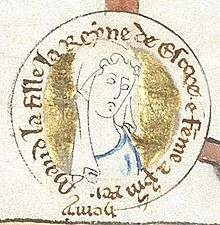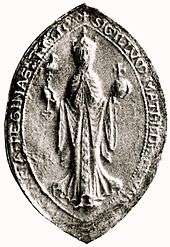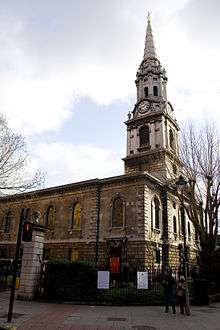Matilda of Scotland
Matilda of Scotland (originally christened Edith,[lower-alpha 1] 1080 – 1 May 1118), also known as Good Queen Maud or Matilda of Blessed Memory, was Queen of England and Duchess of Normandy as the first wife of King Henry I. She acted as regent of England on several occasions in her husband's absence.
| Matilda of Scotland | |
|---|---|
 | |
| Queen consort of England | |
| Tenure | 11 November 1100 – 1 May 1118 |
| Coronation | 11 November 1100 |
| Duchess consort of Normandy | |
| Tenure | 11 November 1100 – 1 May 1118 |
| Born | 1080 Dunfermline, Kingdom of Scotland |
| Died | 1 May 1118 (aged c. 38) Westminster Palace, London, England |
| Burial | |
| Spouse | |
| Issue | |
| House | Dunkeld |
| Father | Malcolm III of Scotland |
| Mother | Saint Margaret of Wessex |
| Religion | Roman Catholicism |
Daughter of the King Malcolm III of Scotland and Princess-Saint Margaret of Wessex, Matilda was sent to be educated in a convent in southern England, where her aunt Cristina was abbess. According to Wilton Abbey's traditions in the 1140s, her aunt ordered her to take the veil in order to protect her from the lust of William II of England, which angered her father because of the affect it might have on her prospects of marriage.[1] In 1093, Matilda was engaged to an English nobleman until her father and her brother Edward were killed in a minor raid. A messy succession conflict in Scotland followed between her uncle Donald III, her half-brother Duncan II and her brother Edgar until 1097, when the latter assumed the throne.
Upon the accession of Henry I in 1100, following his brother William's death while hunting, the English King quickly proposed marriage to Matilda, who possessed the Anglo-Saxon royal blood, which the Norman dynasty largely lacked.[lower-alpha 2] Furthermore, her brother offered the prospect of better relations between the two countries. However, there was a difficulty about the marriage: a special church council was called to be satisfied that Matilda hadn't taken vows as a nun, but her firm testimony managed to convince them of.
As Queen of England since the late 1100, Matilda embarked on several building projects for transportation and health, took a role in government as mediator to the Church, and led a literary court. She acted as regent when her husband was away, with many surviving charters are signed by her. Matilda and Henry had two children: Matilda and William Adelin, Duke of Normandy. She lived to see her daughter become Holy Roman Empress, but died two years before her son's drowning. Her widower remarried, but had no further legitimate children, which caused a succession crisis resulting in a long civil war known as The Anarchy. Queen Matilda was buried in Westminster Abbey and was fondly remembered by her subjects. There was an attempt to have her canonized, which wasn't pursued.
Early life
Childhood
She was born on 1080, in Dunfermline, Scotland. Her parents were King Malcolm III and Princess-Margaret of Wessex, making her descendant from both the Scottish and the Anglo-Saxon royal family since she was the great-granddaughter of Edmund Ironside and henceforth descended from Alfred the Great.[2] The Scottish princess was christened Edith, with the Anglo-Norman prince Robert Curthose standing as godfather at the ceremony. English Queen Matilda of Flanders was present at the baptismal font and served as her godmother. Edith then pulled at Queen Matilda's headdress, which was seen as an omen that the infant would be Queen one day.[3]
Edith, her sister, and her brothers were raised by a loving but strict mother who didn't spare the rod when it came to raising her children in virtue, which some presupposed was the reason for the good behaviour the royal siblings displayed, and Margaret also stressed the importance of piety.[4] When she was about six years old, Edith and her sister Mary were sent to be educated in Romsey Abbey, near Southampton in southern England, where their maternal aunt Cristina was abbess. Their studies went beyond the standard feminine pursuits, which wasn't surprising since her mother was a great lover of books. The princesses learned the languages English, French, and Latin, which were sufficiently to read St. Augustine's works and the Bible.[5] It is presumed that Edith learned financial management and geometry as well.
Succession crisis
During her stay at Romsey and at Wilton Abbey,[6] the still 13-years-old Edith was much sought-after as a bride, with Hériman of Tournai claiming that even King William II of England considered marrying her. She refused proposals from William de Warenne, 2nd Earl of Surrey, and Alan Rufus, Lord of Richmond.[5] However, her parents betrothed Edith to Alan Rufus in 1093. Before the marriage took place, her father entered into a dispute with the English Kinga and marauded the latter's lands, where he was surprised by Robert de Mowbray, Earl of Northumbria, and killed along with his son Edward. Upon hearing of her husband and her son's deaths, Queen Margaret died on 16 November. Shortly afterwards, the orphan princess was abandoned by her betrothed, who ran off with a daughter of Harold Godwinson, Gunhild of Wessex. However, he died before they could be married.[7]
Shortly afterwards, possibly due to the messy succession conflict began in Scotland between her uncle Donald III, her half-brother Duncan II and her brother Edgar. Edith had left the monastery by 1093, when Archbishop Anselm of Canterbury wrote to the Bishop of Salisbury, ordering that "the daughter of the late King of Scotland be returned to the monastery that she had left". However, she didn't return to Wilton and until 1100, is largely unaccounted for in chronicles.[8] In 1097, Edgar assumed the throne.
Problematic engagement
After William II's death in the New Forest in August 1100, his brother Henry immediately seized the royal treasury and crown.[9] He was manipulative and profoundly clever, known for his strict but proper government and utterly merciless nature in case of war or rebellion. His next task was to marry and his choice was Matilda,[10] whom he had known for some time. William of Malmesbury stated that Henry had "long been attached" to her, Orderic Vitalis said that Henry had "long adored" her character and capacity,[11] and some sources adding that she was "not bad looking" despite she didn't improve her appearance through face painting.[12] It is possible that Edith had spent some time at William Rufus's court and that the pair had met there, but Henry could have been introduced to her by his teacher Bishop Osmund.[11]
Since Edith was the granddaughter of Edmund Ironside from the royal family of Wessex, Henry wanted to marry her because, although he had been born in England, he needed a bride with ties to the ancient Wessex line to increase his popularity with the English and to reconcile the Normans and Anglo-Saxons.[13] In their heirs, the two factions would be united, further unifying the new regime. Another benefit was that England and Scotland became politically closer; three of her brothers became Kings of Scotland in succession and were unusually friendly towards England: Alexander I married Sybilla, one of Henry I's illegitimate daughters, and David I lived at Henry's court for some time before his accession.[14]
Because Edith had spent most of her life in a convent, there was some controversy over whether she was a nun and thus canonically ineligible for marriage.[10] During her time at Romsey Abbey, her aunt Cristina forced her to wear the veil.[15] Strong-willed, Edith was ready to fight for her status as a marriageable woman rather than staying in a monastery. When Archbishop Anselm of Canterbury returned to England after a long exile, she sought him out to convince him that she had never been a nun. In fact, she hadn't only been forced to wear a veil, but her father had "ripped off the offensive headdress [...] and tore it to shreds" at sight of her being veiled.[16]
Professing himself unwilling to decide so weighty a matter on his own, Anselm called a council of bishops in order to determine the canonical legality of the proposed marriage and ordered two inquiries at Wilton to get first-hand information on the matter. Edith testified that she had never taken holy vows, insisting that her parents had sent her to England for educational purposes[17] and her aunt had veiled her to protect her "from the lust of the Normans."[6], but she had pulled the veil off and stamped on it, which made her aunt beat and scold her. The council concluded that Edith wasn't a nun, never had been and her parents hadn't intended that she become one, giving their permission for the marriage.[18]
Queen of England

_p18b_-_Bow_Bridge.jpg)

After Edith and Henry were married on 11 November 1100 at Westminster Abbey by Archbishop Anselm of Canterbury, she was crowned as "Matilda," a hallowed Norman name. By courtiers, however, she and her husband were soon nicknamed 'Godric and Godiva',[19] two typical English names from before The Conquest in derision of their more rustic style, especially when compared to William II's flamboyance. Despite this, Matilda's court at Westminster was filled with poets. She was known as a patron of the arts, especially music.[20]
Building projects
Matilda had a small dower but it did incorporate lordship rights, which allowed her to administer her properties. Most of her dower estates were granted from lands previously held by Edith of Wessex. Additionally, King Henry made numerous grants to the Queen, including substantial property in London, a political move made in order to win over the unruly Londoners who were vehement supporters of the Wessex Kings.[21]
Matilda had a great interest in architecture and used her considerable income to instigate the construction of many Norman-style buildings, including Waltham Abbey and Holy Trinity Aldgate.[22] After her retinue encountered problems crossing the River Lea to get to Barking Abbey, the Queen built the first arched bridge in England at Stratford-le-Bow, with a causeway across the marshes.[23]
Like her mother, Matilda was renowned for her devotion to the poor, building public lavatories at Queenhithe and a bathhouse with piped-in water.[23] She exhibited a particular interest in leprosy, founding at least two leper hospitals, including the institution that later became the parish church of St Giles-in-the-Fields.[20]
Diplomacy
Acting as regent of England during her husband's frequent absences for military campaigns in Normandy and France, Matilda was the designated head of King Henry's curia. She went on travels around England and probably visited Normandy circa 1106–1107.[24]
During the English investiture controversy (1103–07), Matilda acted as intercessor between King Henry and Archbishop Anselm. She wrote several letters during Anselm's absence, first asking him for advice and to return, but later increasingly to mediate.[25] With the Queen's help, the issue was resolved through a compromise solution in 1105: the King gave up the right to pick and invest his own bishops, but the Church agreed that he could receive homage from the bishops for the temporal lands the Church held in his domains.
Almost a Saint
Queen Matilda was described as "a women of exceptional holiness, in piety her mother's rival, and in her own character exempt from all evil influence."[26] She was remembered by her subjects as Mathilda bona regina[27] and for a time sainthood was sought for her, though she was never canonized.
Matilda was known for her generosity towards the church,[28] founding and supporting cloisters and hospitals for leprosies.[29] Malmesbury described her as attending church barefoot at Lent, as well as washing the feet and kissing the hands of the sick.[20] Queen Matilda was patroness of the monk Bendeit's version of The Voyage of Saint Brendan, written around 1106–1118.[30] She also commissioned the monk Thurgot of Durham, to write a biography of her mother, Saint Margaret.[20]
Issue

Although her husband had a number of illegitimate children by various mistresses, Matilda and Henry had at least two children who reached adulthood:
- Matilda (7 February 1102 – 10 September 1167): Became Lady of the English after The Anarchy. By marriage, she was Holy Roman Empress and Countess of Anjou.
- William (5 August 1103 – 25 November 1120): Called "Adelin". Became Duke of Normandy. Married Matilda (d.1154), daughter of Count Fulk V of Anjou.
The couple possibly had a stillborn child in July 1101, but historians aren't entirely sure whether there is enough evidence for this. Many, such as Chibnall, have claimed that there was no pregnancy before the one with Empress Matilda "as it allows no time for a normal second pregnancy".[31]
Through her, the post-Norman conquest English monarchs were related to the Anglo-Saxon House of Wessex monarchs.[14]
Death and legacy
On 1 May 1118, Matilda died at Westminster Palace. She would have liked to have been buried at Holy Trinity, Aldgate, but King Henry asked for her to be buried at Westminster Abbey[32] near Edward the Confessor.[33] The inscription on her tomb reads: "Here lies the renowned queen Matilda the second, excelling both young and old of her day. She was for everyone the benchmark of morals and the ornament of life."[34]
The death of Matilda's son, William Adelin, in the disaster of the White Ship (November 1120) and her widower's failure to produce a legitimate son from his second marriage led to the succession crisis and, as a consequence, a long civil war.[35] During his reign, Stephen of Blois insisted that Queen Matilda had in fact been a nun and that her daughter, Empress Matilda, was therefore not a legitimate successor to the English throne.[27]
Queen Matilda's reputation considerably improved throughout her grandson's reign, but she was remembered to a continuously lesser extent between the late 13th and 14th centuries.[27]
Notes
- She is known to have been given the name "Edith" (the Old English Eadgyth, meaning "Fortune-Battle") at birth, and was baptised under that name. She is known to have been crowned under a name favoured by the Normans, "Matilda" (from the Germanic Mahthilda, meaning "Might-Battle"), and was referred to as such throughout her husband's reign. It is unclear, however, when her name was changed, or why. Accordingly, her later name is used in this article. Historians generally refer to her as "Matilda of Scotland"; in popular usage, she is referred to equally as "Matilda" or "Edith".
- Though Matilda of Flanders, wife of William the Conqueror and Henry's mother, was descended from Alfred the Great
References
- Tyler 2017, p. 308.
- Hollister 2001, p. xxii.
- Huneycutt 2003, pp. 9–10.
- Turgot 1884.
- Hilton 2010, p. 42.
- Hollister 2001, p. 128.
- Hilton 2010, pp. 42–43.
- Hilton 2010, p. 43.
- Hollister 2001, pp. 102–104.
- Hollister 2001, pp. 126, 128.
- Hilton 2010, p. 45.
- Green 2006, p. 57.
- Hilton 2010, pp. 44–45.
- Hollister 2001, p. 126.
- Huneycutt 2003, p. 17.
- Huneycutt 2003, pp. 21, 28.
- Huneycutt 2003, p. 28.
- Huneycutt 2003, pp. 17–18, 28.
- Huneycutt 2003, p. 73.
- Hilton 2010, pp. 47–48.
- Hilton 2010, pp. 46–47.
- Hilton 2010, p. 53.
- Hilton 2010, p. 63.
- Hilton 2010, p. 50.
- Huneycutt 2003, p. 76.
- Weir 2017, p. 126.
- Huneycutt 2003, pp. 146–48.
- Green 2006, pp. 57–58.
- Huneycutt 2003, pp. 103, 105–106.
- Ritchie 1950.
- Chibnall 1992, p. 9.
- Green 2006, pp. 139–140.
- Tyler 2017, p. 302.
- Green 2006, p. 140.
- Tyler 2017, p. 303.
Sources
- Chibnall, Marjorie (1992). The Empress Matilda: Queen Consort, Queen Mother, and Lady of the English. Oxford, UK Cambridge, Mass: Blackwell. ISBN 9780631157373. OCLC 29924153.
- Green, Judith (2006). Henry I : King of England and Duke of Normandy. Cambridge: Cambridge University Press. ISBN 9780521591317. OCLC 61757059.
- Hilton, Lisa (2010). Queens Consort: England's Medieval Queens from Eleanor of Aquitaine to Elizabeth of York. New York, NY: Pegasus Books LLC. ISBN 9781605981055. OCLC 649718519.
- Hollister, C. Warren (2001). Frost, Amanda Clark (ed.). Henry I. New Haven: Yale University Press. ISBN 9780300143720. OCLC 907375996.
- Huneycutt, Lois L. (2003). Matilda of Scotland: A Study in Medieval Queenship. Rochester, NY: Boydell Press. ISBN 9781846151149. OCLC 229990725.

- Turgot (1884). Life of St. Margaret Queen of Scotland. Translated by Forbes-Leith, William. Edinburgh: W. Paterson. OCLC 697981344. Retrieved 2020-05-25.
- Tyler, Elizabeth Muir (2017). "Edith Becomes Matilda". England in Europe : English Royal Women and Literary Patronage, c. 1000–c. 1150. Toronto Buffalo London: University of Toronto Press. pp. 302–353. ISBN 9781442685956. JSTOR 10.3138/j.ctt1whm96v.14. OCLC 984991708.
- Weir, Alison (2017). Queens of the Conquest: England's Medieval Queens. London, England: Penguin Random House UK. ISBN 9781910702079. OCLC 1003999244.
External links
| Wikimedia Commons has media related to Matilda of Scotland. |
- Matilda 3 at Prosopography of Anglo-Saxon England
- Medieval Women: The Life Of St Margaret, Queen Of Scotland By Turgot, Bishop of St Andrews Ed. William Forbes-Leith, S.J. Third Edition. Edinburgh: David Douglas, 1896 . Retrieved 14 March 2011.
Matilda of Scotland Born: c. 1080 Died: 1 May 1118 | ||
| English royalty | ||
|---|---|---|
| Vacant Title last held by Matilda of Flanders |
Queen consort of the English 11 November 1100 – 1 May 1118 |
Vacant Title next held by Adeliza of Louvain |